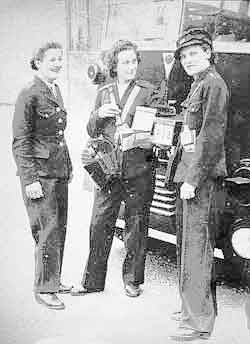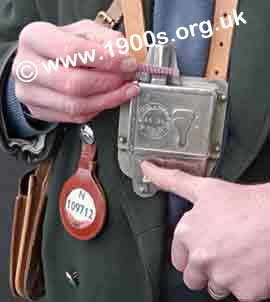Bus conductors on London Transport buses, mid 20th century
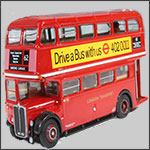
In the mid-20th Century, London Transport buses had a conductor as well as a driver. This page is about the role and work of the bus conductor, much of which has today been passed over to the driver, the work being eased by push-button digital technology.
____
By the webmaster, based childhood observations, discussions with people who lived with these buses and additional research
When I was growing up in 1940s and 1950s in the wider London area, every bus had a conductor as well as a driver.
Most of my recollections are of bus conductors being men, but during the Second World War war, they were usually women or older men because young and fit men were away on active service. The women were known as clippies.
Uniforms of bus conductors and clippies
London bus conductors and clippies had dark navy uniforms with peaked caps and they wore various badges. The uniforms of the few rural bus conductors who I saw were identical but in dark green.
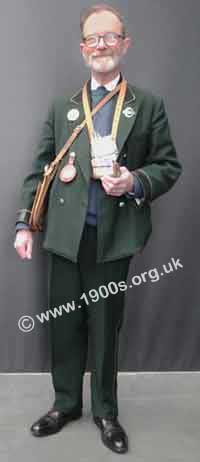
Graham Burgess in authentic bus conductor kit - but without the hat
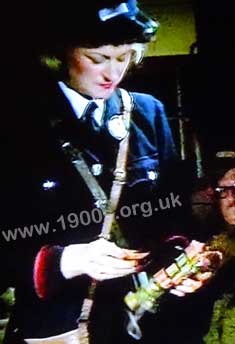
Clippy, mid 20th century
Bus conductor identification badges
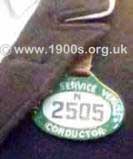
Identification of a London bus
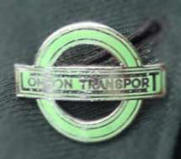
London Transport lapel badge
The role of bus conductors
Bus conductors were in charge of their buses. They monitored safety and signalled to their driver when it was safe to drive off after a stop. This signalling was via one of the bells that were on display inside the bus. I seem to remember that it was one ding to stop and two to start again. I suspect that drivers stopped anyway at regular bus stops, although request stops were different. But I never knew a driver to start off again without the conductor's instruction which was via two tings at the bell. I remember these two tings as if they were yesterday.
In particular, bus conductors collected passengers' fares, i.e. they sold the bus tickets. They also reset the route displays at the front and back of the bus. More of both below.
Bus conductors' role selling bus tickets
Bus tickets could not be bought in advance.
Bus conductors sold the bus tickets once passengers were settled on the bus, This had the huge advantage that the time spent at bus stops was minimal - only long enough to allow passengers on and off. So journey times were much shorter then than in the later years of single operators doubling as driver and conductor, collecting fares from an entire queue at each bus stop before moving off again.
To sell the tickets, bus conductors moved up and down the passage between the seats selling tickets as the bus was moving. There is a separate page on bus tickets.
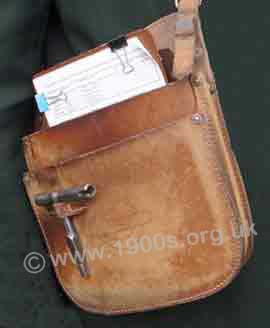
Leather shoulder bag with pockets for coins and documents.
The gadget on the left is for unlocking his personal compartment and for winding on the route display - see below.
Often, as the buses were very crowded, the conductors had to squeeze past the standing passengers. Officially only five standing passengers were allowed on the lower deck and none on the upper deck, but the conductors were often kind enough to allow more when the weather was cold or raining.
A conductor collected passengers' money in a leather pouch slung over the neck and shoulders. There were separate slots in these pouches for documents and different coins, probably for silver and copper. I seem to remember notes being kept in conductors' pockets, but there were few of them. The value of money was such that in normal circumstances no bus journey would cost as much as a note, and conductors certainly did not like being asked to give change for them!
Passengers told the conductor their destination and he - having invariably remembered where they got on - seemed to know immediately what the fare would be. He then pulled out an appropriate ticket from the rack and punched a hole in it. I suppose the hole must have been over the destination point, but I can't remember ever checking.
Conductors always seemed to be remarkably good at remembering who had and had not paid - or maybe everyone was more just honest then. It was certainly common practice for passengers to hold their money out to show that they still needed to pay.
Bus conductors' role reseting the route display
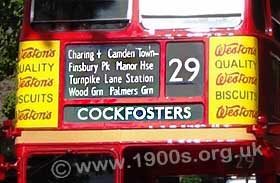
Display showing bus destinations and route numbers.

Bus 'blind' display
The destination of a bus was shown as white text on black in display windows at the front and back.
As there was of course no electronic means of display, each bus carried a length of lettering showing appropriate information for routes on which the bus might run. It was known as the 'blind' and was stored on a reel and wound on every time the route changed, normally at a terminus where the bus turned round. In practice, it was wound on a few minutes before the terminus, as bus conductors wanted to rush off for their break. Presumably they were also expected to do some financial admit then too.
Routes and times were also displayed on the posts of some bus stops.
| sources | webmaster | contact |
Text and images are copyright
If you can add anything to this page or provide a photo, please contact me.


